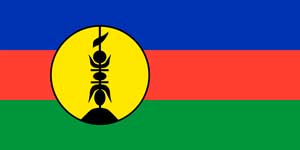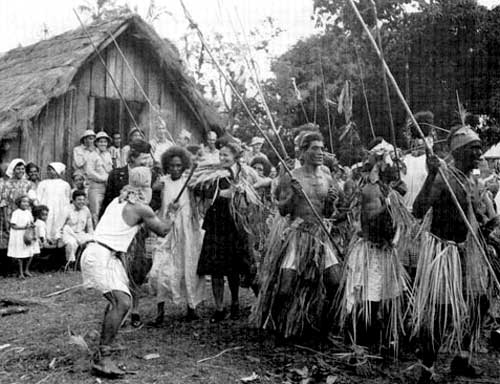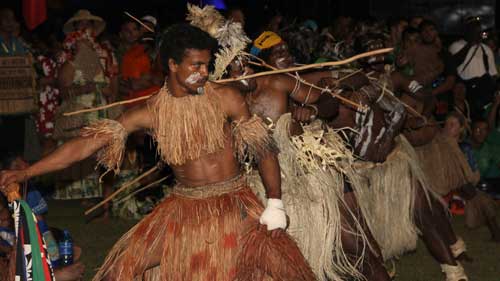POP Cultures: New Caledonia
Map
Flag

Quick facts
Official Name: New Caledonia/Nouvelle Calédonie
Indigenous Peoples: Kanak
Official Languages: French; regional languages: Drehu. Nengone, Paici, Aijie, Xaracuu and 35 other native languages
Political Status: Special Collectivity (Self-governing territory of France)
Capital: Noumea
Population: 268,767 (2014 est.)
Greeting: Bonjour
History and geography

New Caledonia is a self-governing territory of France, also known as a Special Collectivity, located about 1210 km (750 mi) east of Australia and 16,136 km (10,025 mi) east of France. The archipelago includes the main island of Grande Terre, the Loyalty Islands, the Chesterfield Islands, the Belep archipelago and the Isle of Pines. It is the third largest Pacific island nation behind Papua New Guinea and New Zealand. The total land area is roughly 18,876 sq km (7,172 sq mi). New Caledonia’s population is a mix of Kanak people (descendants of the original inhabitants of New Caledonia), Polynesians, French, Pied-Noir and Maghreban descendants, and Southeast Asian peoples.
The land mass of New Caledonia is derived from the ancient super-continent of Gondwana and the area referred to as Zealandia, which separated from what is now Australia about 60 to 85 million years ago. A central mountain range divides the New Caledonia mainland. There are also savannas and plains, as well as evergreen forests. New Caledonia also has one of the largest lagoons in the world, and is home to an array of unique flora and fauna. The climate is hot and tropical, with occasional cyclones and dry periods. The capital, Noumea, is modeled after European cities and is located in the southwestern part of the island. The country has over 3,500 varieties of plants of which three-quarters are endemic, and over 4,300 species of terrestrial animals, 1,000 species of fish and 6,500 marine invertebrates.
The earliest human inhabitants of New Caledonia are believed to be Lapita peoples, a cultural group known for their sophisticated pottery styles, seafaring and agricultural technology. Evidence of Lapita culture can be found through much of the Pacific, including Melanesia and Polynesia. These early people arrived over 3,000 years ago. A more recent wave of migration occurred about 900 years by people mostly from Polynesia.
The first European to see New Caledonia was British Captain James Cook in 1774, on his way to New Zealand aboard his ship, HMS Resolution. He named the main island New Caledonia because the island reminded him of Scotland (“Caledonia” being the former name for Scotland). The French explorer Jean-Francois de Galaup sighted Grande Terre in 1778, and the Loyalty Islands were seen in 1796. During these early years, very few outsiders came to New Caledonia, until the sandalwood trade emerged in the mid-1800s. When the trade declined, many people from New Caledonia, Solomon Islands, Papua New Guinea and New Hebrides were forced to labor in sugar plantations in Fiji and Australia through a type of slave trade known as blackbirding. The term kanak emerged (from the Hawaiian word kanaka, meaning “man”) to designate particularly the Melanesian natives. Protestant missionaries from the London Missionary Society and Catholic Marist Brothers introduced Christianity to the islanders.
In 1854, France formally claimed New Caledonia as a French colony, using it primarily as a penal colony. The first boatload of convicts arrived in 1864. Over a period of about 30 years more than 22,000 prisoners were sent to New Caledonia. Some of the prisoners eventually settled in the colony as free people.
When nickel was discovered in 1864, the French imported laborers to work in the mines, leaving the indigenous people out of the colony’s economy, and relegating them to reservations. A rebellion ensued in 1878 after several of the native tribes unified against the French colonial government, and many French and native islanders died through guerrilla warfare. Even more natives died from exposure to diseases brought in by the Europeans.
During World War II, New Caledonia became an important Allied base, and the headquarters of the United States Army and Navy in the South Pacific. The Americans introduced things like chewing gum and Coca-Cola. After the war, in 1946, New Caledonia became an overseas territory of France, and French citizenship was granted to all New Caledonians in 1953.
As the population of Europeans and Polynesians has grown, the Melanesian population has become a minority, but remains the largest ethnic group.
Political unrest in the 1970s and 1980s culminated in the Matingnon Agreements of 1988, which brought some political stability for a decade. The Noumea Accord of 1998 represents the transition to greater autonomy. A referendum for self-determination is in progress.
Arts and culture

Kanak culture is exemplified by traditions and customs that believe in and rely on the strength of community. Land is owned and shared by everyone. Yam cultivation is central to life and yearly activities revolve around the growing and gifting of this important food source.
Being an oral culture, storytelling is held in high regard among New Caledonians. Other traditional art forms include wood carving, especially of “houp” wood (Montrouziera cauliflora), which is shaped into totem poles, masks, carved doorjambs or doorposts, or the “flèches faîtières” arrows. Wooden sculptures decorated the roofs of large ceremonial houses, representing the founding ancestor of a clan. Basket weaving is also commonly practiced among women.
Music styles popular in New Caledonia include the tribal dances performed to the traditional pinou beat, as well as the modern kaneka style, which evolved in the 1980s, and was inspired by reggae.